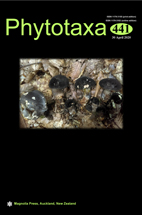Abstract
Pseudohydnum brunneiceps is described as a new species from Jiangxi Province, central China. Morphologically, it is characterized by a gelatinous basidiocarps, pilei pale yellowish brown, dark reddish brown to blackish velutinate, spines conical and white, and basidiospores globose to broadly ellipsoidal. Phylogenetic analyses of DNA sequences from partial 28S region and internal transcribed spacer (ITS) also confirm that P. brunneiceps forms an independent lineage within Pseudohydnum. A description, photographs of the fresh basidiomata and line-drawings of the microstructures are provided. In addition, the previous records of P. gelatinosum in China should be re-evaluated by more representative samples by molecular phylogeny.

